Hi-Stat Vox No. 13 (May 19, 2010)
Explaining Fertility Trends in Russia
Kazuhiro Kumo
Associate Professor, Institute of Economic Research, Hitotsubashi University

Exceptionally low birth rates in transitional economies
Declining birth rates have long been a subject of debate in a large number of countries. This is also the case in the former communist countries of Eastern Europe, where birth rates have been falling since the early 1990s, when these countries began their transition to capitalism, through to the 21st century. In 1990, the total fertility rates (TFRs) in these countries were generally higher than those in Western European countries. They declined rapidly from that point onwards, however, resulting in TFRs of less than 1.7 in every region except Central Asia, the Caucasus countries, Moldova (all underdeveloped regions that used to be part of the Soviet Union), Albania, and Montenegro by the year 2000. Most of these countries actually had birth rates of less than 1.5 (Table 1).
Table 1: Total Fertility Rates in Former Communist Countries

Source: World Bank (2009).
Needless to say, this also applies to the Russian Federation. Whereas Russia's TFR was 2.01 in 1989, it plummeted after the beginning of the transition to capitalism and fell below 1.20 in both 1999 and 2000. Intuitively, a number of potential reasons for this drop spring to mind. The decline in incomes that accompanied the sharp fall in GDP obviously made it more difficult for families to cover the cost of childrearing. Uncertainty with regard to the future can also be assumed to have had a negative effect on birth rates. In addition, with the employment rate among women, which had been high in the days of the former Soviet Union, remaining more or less unchanged, the fact that nurseries, kindergartens and other public facilities providing childrearing assistance, which previously had generally been free, started charging for their services and company-run kindergartens and other facilities began closing one after another is likely to be another reason.1
Russia's total population began falling in 1992 (Figure 1), prompting the Russian government to announce various measures to stem this decline. In 2001, with the TFR having dropped below 1.2 in 1999 and 2000, the Russian federal government formulated a plan to halt the population decline by 2015.2 The plan set out guidelines for improving the health of citizens and implementing measures to raise the birth rate. However, as with so many other “plans” formulated by the Russian government,3 it would be difficult to argue that it had any real significance, since no new measures to tackle the declining birth rate and rising death rate were introduced at the time.
Figure 1: Number of Births and Deaths in Russia
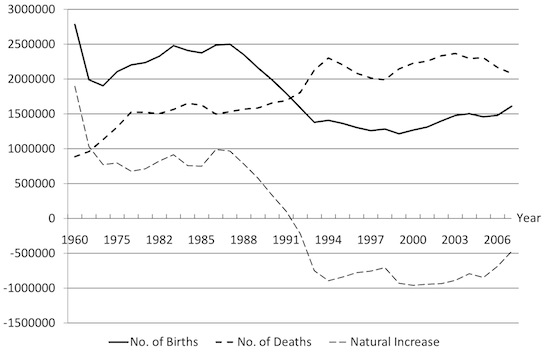 Source: Prepared by the author based on data from Rosstat (2008).
Source: Prepared by the author based on data from Rosstat (2008).
Childbirth incentives and fertility trends in Russia since 2005
The annual state of the nation addresses given by then-President Putin in 2005 and 2006 also touched on the problem of Russia's low birth rate and singled out raising the birth rate as a policy goal. This led to childrearing allowances and other benefits being raised in December 20064 and the establishment of a childrearing support scheme called the Mothers' Fund.5 The Mothers' Fund provides parents of two or more children with a total of 250,000 rubles (approximately ¥1.2 million at the time) in subsidies for use on housing, education, or pension contributions, and is available to children born or adopted between January 1, 2007 and December 31, 2016. Given that the average monthly income in Russia in September 2007 was 12,000 rubles, the value of these subsidies is huge.6 It was against this backdrop that, on October 9, 2007, a presidential order was issued to halt the population decline by 2025.7 Unlike the various plans formulated previously, this presidential order was accompanied by actual policies.
The number of births meanwhile has been rising almost continuously since 1999 (Figure 1). As the number of deaths has also remained high on the whole however, the overall natural decline in the population has not been halted. Nevertheless, vital statistics for 2007, 2008 and 2009 show that the crude birth rate and the TFR have been at their highest level since the collapse of the Soviet Union for three consecutive years (Figure 2). The total population is also declining at a reduced rate (Figure 1).
Figure 2: Total Fertility Rate in Russia
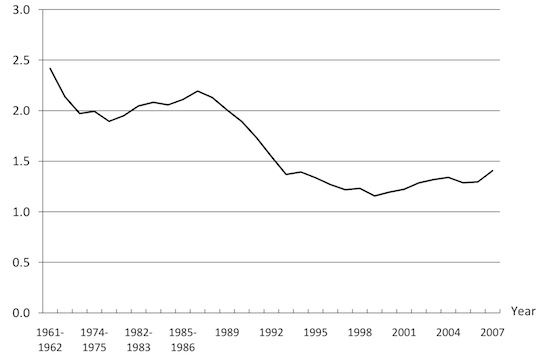 Source: Prepared by the author based on data from Rosstat (2008).
Source: Prepared by the author based on data from Rosstat (2008).
In the second half of 2007, by which time a steady upward trend in the number of births was observed, then-President Putin and cabinet ministers stated on several occasions that their population policies were already having an effect.8 Although the claim that political measures introduced in January 2007 were already influencing fertility trends by June that same year is little more than political spin, stemming from the unavoidable temptation to emphasize the effectiveness of government policy, several articles in the media presented it as fact.
The situation just described raises a number of questions. What does explain the observed rise in the birthrate since 2007? In particular, what role do economic developments play? What effect do the cash payments in return for having children have on the number of births and the fertility rate? And what are the implications of these factors for the prospects of future fertility trends in Russia?
Income levels and fertility
Let us start by looking at trends in Russia's GDP and the TFR. Figure 3, which plots these against each other, gives the general impression that there is a correlation between the two. The correlation coefficient for data from 1991 to 2007 however is only 0.56, which for annual time series data does not imply a strong correlation. It therefore seems fair to say that the correlation between economic growth and the fertility rate is more apparent than real.
Figure 3: GDP and TFR in Russia (1991-2007)
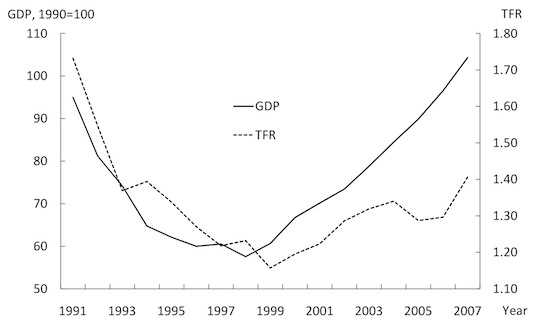 Source: Prepared by the author based on data from Rosstat (2008) and RSE, 2002, 2003, 2009.
Source: Prepared by the author based on data from Rosstat (2008) and RSE, 2002, 2003, 2009.
Consequently, for a more rigorous analysis, we recently examined the determinants of childbirth employing micro-data from the Russia Longitudinal Monitoring Survey (RLMS). Specifically, using a sample of women aged 15 to 49 from each round from 1995 (Round V) to 2004 (Round XIII), we conducted a regression analysis using individual characteristics as explanatory variables and whether or not the woman gave birth during the following round as the dependent variable. The pooled sample consisted of over 15,000 observations. The main results of the regression are presented in Table 2, some of which will be interpreted below.9
The first finding that can be gleaned from Table 2 is that household income is not a determinant of the probability of childbirth. This finding is in line with previous research into childbirth in Western European countries, which has clearly established that there is no linear relationship between personal income and the probability of childbirth. Instead, the apparent correlation between GDP and the fertility rate seen above seems to reflect the turmoil accompanying the collapse of the Soviet Union and the subsequent return of economic growth and social stability. In other words, the fact that Russia's fertility rate plummeted following the economic transition may have been the result of the extreme uncertainty regarding prospects for the future associated with the dramatic decline in income. Consequently, the return of economic growth and social stability may have helped to raise Russia's fertility rate to some extent. This is also evident from the fact that the subjective notion of ”satisfaction with life“ also significantly influences the probability of childbirth. However, the insignificant coefficients on the household income and expenditure variables shown in Table 2 suggest that the return of economic growth has at best only had an indirect impact on the fertility rate.
Table 2: The Determinants of Childbirth in Russia
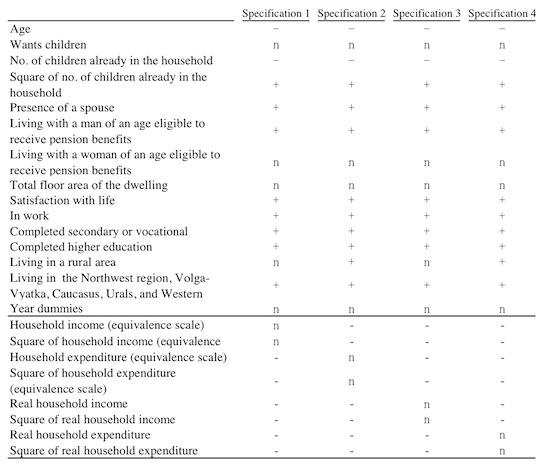 Source: Estimated by the author based on forms returned from the Russia Longitudinal Monitoring Survey.
Source: Estimated by the author based on forms returned from the Russia Longitudinal Monitoring Survey.
Notes:
+ statistically significant and positive;
- statistically significant and negative;
n not significant.
Of considerable interest in this context is a second result, namely that more educated women are more likely to have children. This phenomenon that having completed higher education is associated with a higher probability of giving birth is unusual given the experience of other countries, where the completion of higher education is typically associated with a lower probability of giving birth because such women delay marriage and childbirth and have greater awareness regarding health and contraception. So how can this phenomenon be explained? One possible explanation is that in the context of the social turmoil and sharp decline in incomes experienced during the 1990s educational attainment is a proxy for permanent income. The fact that employment and the level of satisfaction with life also have a significant impact on the probability of giving birth can be interpreted along the same lines.
Demographic factors
As elsewhere, the rate of childbirth in Russia is affected by a range of factors simultaneously, including economic growth, incomes, the outlook on life, and social stability. This means that it is difficult to determine the specific effects of childbirth incentive measures such as the Mothers' Fund.
In terms of the number of births rather than the birth rate, it goes without saying that demographic factors also need to be taken into consideration. Although the number of births is obviously influenced to a large extent by fluctuations in the number of women of reproductive age, opinion varies as to whether the number of births has increased or decreased once that factor is taken out of the equation.10
Figure 4: Population Pyramid for Russia in 2004 (1,000 people)
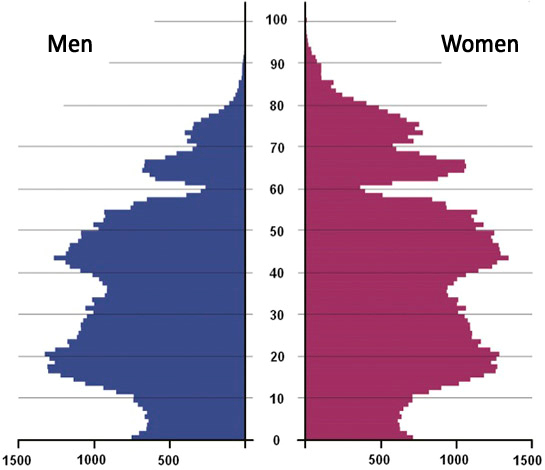 Source: Prepared by the author based on the internal document supplied by Rosstat.
Source: Prepared by the author based on the internal document supplied by Rosstat.
Figure 4 shows the population pyramid for Russia at the start of 2004, where the bulge in the population in their 40s reflects the increase in the number of births following the Second World War. The bulge in the population in their 20s meanwhile represents the generation of their offspring. To reiterate, this is a population pyramid for 2004, meaning that those in their 20s at the beginning of the 21st century were yet to reach their peak age for fertility. Essentially, even in the absence of any measures to boost the birth rate, consistently high crude birth rates were to be expected during the first 10-20 years of the 21st century. In fact, Rosstat, the Russian Federal State Statistics Service, had already predicted, in 2004, that the birth rate would climb continuously until 2016.11 It goes without saying that the number of people of reproductive age plays a key role in the number of births. As such, it is clearly meaningless to consider the impact of childbirth incentive measures unless the impact of this factor is excluded. Moreover, it is possible that even if the Mothers' Fund has helped to lift the birth rate since 2007, all it may be doing is to bring forward the timing of births that might have happened in the future anyway, so there is also a possibility that the birth rate will decline again at a later date. In fact, in 2009 Rosstat revised its forecast from 2004 and is now predicting that the birth rate will stop rising in 2011 (as opposed to 2016, as forecast in 2004).12
There has also been a continuous upward trend in Russia's TFR since 2005. However, the experience of other countries indicates that fertility is not solely determined by short-term factors such as rising incomes or by the economic climate, as analyses based on micro-data show. Experience also suggests that childbirth incentive measures may only have a short-term impact. There are questions meanwhile over the sustainability of providing cash payments in return for childbirth on a scale that exceeds average incomes, as is the case with the Mothers' Fund. Even if recent increases in Russia's fertility rate are attributable to the impact of the Mother's Fund, payments are only going to be available to those having children until the end of 2016, after which time the country's fertility rate will presumably start to decline. However, the only way to determine if fertility trends since 2006 will be sustained is to monitor trends over the long term.
Footnotes
- See, e.g., Vechernaya Moskva, No. 37, Feb. 3, 2007, and Vechernii Peterburg, Aug. 25, 2009.
- Rasporyazhenie pravitel' stva RF ot 24.09.2001 No.1270-r.
- A simple example of such plans is the long-term development program for the Far East and the Transbaikal region (Postanovlenie pravitel' stva RF ot 15.04. 1996 No. 480). For a subsequent assessment of the plan to halt the population decline by 2015, see Milonov (2006), Chairman of the Federation Council of Russia.
- Federal'nyi zakon ot 5 dekabrya 2006, No.207-FZ o bnesenii izmenenii v otdel'nye akty Rossiiskoi Federatsii v chasti gosudarstvennoi podderzhki grazhdan, imeyushchikh detei.
- Federal'nyi zakon ot 29 dekabrya 2006, No.256-FZ o dopolnitel’nykh merakh gosudarstvennoi podderzhki semei, imeyushchikh detei.
- Rossiiskaya gazeta, Feb. 14, 2008.
- Kontseptsiya demograficheskoi politiki RF do 2025 g., 9 oktyabrya 2007 No.1351.
- Izvestiya, June 1, 2007; Rossiiskaya gazeta, Dec. 25, 2007.
- For details, see Kumo (2009).
- See, e.g., Antonov (2008), Zakharov (2008), Rosstat (2009) and the Moscow Times (July 11, 2008).
- Data provided by Rosstat.
- Rosstat website (http://www.gks.ru/free_doc/new_site/population/demo/progn5.htm), accessed March 21, 2010.
References
Antonov, A. I. (ed.) (2008), Monitoring demograficheskoi situatsii v Rossiiskoi Federatsii i tendentsii ee izmeneniya, Moscow, Sotsiologicheskii fakritet MGU (in Russian).
Kumo, K. (2009), “Determinants of Childbirth in Russia: A Micro-Data Approach,” Global COE Hi-Stat Discussion Paper Series No. 104, Hitotsubashi University.
Milonov, S. (2006), “Sem'ya - osnova gosudarstva, predsedatel' Soveta Federatsii - o demograficheskoi politike strany,” Parlamentskoe obozrenie No. 4 (20) (in Russian).
Rosstat (2008), Demograficheskii Ezhegodnik Rossii, Moskva, Rosstat (in Russian).
Rosstat (2009), Demograficheskaya situatsiya v Rossiiskoi Federatsii, material distributed at the All-Russian Conference of Statistician held on February 11-12, 2009 (in Russian).
RSE: Rossiiskii statisticheskii ezhegodnik, Moscow, Rosstat, various years (in Russian).
World Bank (2009), World Development Indicators 2008, the World Bank.
Zakharov, S. (2008), “Rossiiskaya rodzdaemost: dolgodzdannyi rost?”, Demoskop Weekly, No.353-354 (in Russian).